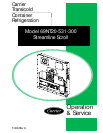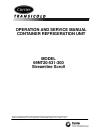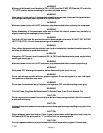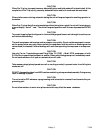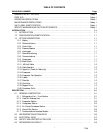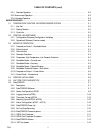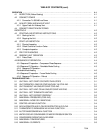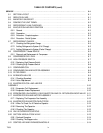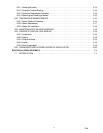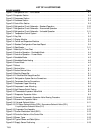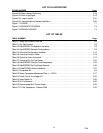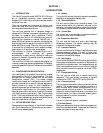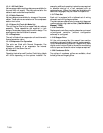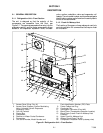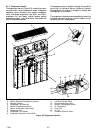Safety-2
T -309
WARNING
Make sure that the unit circuit breaker(s) (CB-1 & CB-2) and the START-STOP switch (ST) are in the
“O” (OFF) position before connecting to any electrical power source.
WARNING
Never use air for leak testing. It has been determined that pressurized, mixtures of r efrigerant and air
can undergo combustion when exposed to an ignition source.
WARNING
Make sure power to the unit is OFF and power plug disconnected before replacing the compressor.
WARNING
Before disassembly of the compressor make sure to relieve the internal pressure very carefully by
slightly loosening the couplings to break the seal.
WARNING
Oakite No. 32 is an acid. Be sure that the acid is slowly added to the water. DO NOT PUT WATER
INTO THE ACID -- this will cause spattering and excessive heat.
WARNING
Wear rubber gloves and wash the solution from the skin immediately if accidental contact occurs. Do
not allow the solution to splash onto concre te.
WARNING
Always turn OFF the unit circuit breakers (CB-1 & CB-2) and disconnect main power supply before
working on moving parts.
WARNING
Make sure power to the unit is OFF and power plug disconnected before removing capacitor(s).
WARNING
With power OFF discharge the capacitor before disconnecting the circuit wiring.
WARNING
Do not use a nitrogen cylinder without a pressure regulator. Do not use oxygen in or near a refrigera-
tion system as an explosion may occur.
WARNING
Do not open the condenser fan grille before turning power OFF and disconnecting power plug.
WARNING
The Unit Power Plug Must Be Disconnected To Remove Power From Circuit Breaker Cb1
CAUTION
Do not remove wire harnesses from controller modules unless you are grounded to the unit frame with
a static safe wrist strap.
CAUTION
Unplug all controller module wireharness connectors beforeperforming arc weldi ngon any partofthe
container.
CAUTION
When condenser water flow is below 11 lpm (3 gpm) or when water-cooled operation is not in use, the
CFS switch MUST be set to position ”1” or the unit will not operate properly.
CAUTION
Pre-trip inspection should not be performed with critical temperature cargoes in the container.



